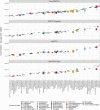An assessment and characterization of pharmaceuticals and personal care products (PPCPs) within the Great Lakes Basin: Mussel Watch Program (2013-2018)
- PMID: 38438687
- PMCID: PMC10912168
- DOI: 10.1007/s10661-023-12119-3
An assessment and characterization of pharmaceuticals and personal care products (PPCPs) within the Great Lakes Basin: Mussel Watch Program (2013-2018)
Abstract
Defining the environmental occurrence and distribution of chemicals of emerging concern (CECs), including pharmaceuticals and personal care products (PPCPs) in coastal aquatic systems, is often difficult and complex. In this study, 70 compounds representing several classes of pharmaceuticals, including antibiotics, anti-inflammatories, insect repellant, antibacterial, antidepressants, chemotherapy drugs, and X-ray contrast media compounds, were found in dreissenid mussel (zebra/quagga; Dreissena spp.) tissue samples. Overall concentration and detection frequencies varied significantly among sampling locations, site land-use categories, and sites sampled proximate and downstream of point source discharge. Verapamil, triclocarban, etoposide, citalopram, diphenhydramine, sertraline, amitriptyline, and DEET (N,N-diethyl-meta-toluamide) comprised the most ubiquitous PPCPs (> 50%) detected in dreissenid mussels. Among those compounds quantified in mussel tissue, sertraline, metformin, methylprednisolone, hydrocortisone, 1,7-dimethylxanthine, theophylline, zidovudine, prednisone, clonidine, 2-hydroxy-ibuprofen, iopamidol, and melphalan were detected at concentrations up to 475 ng/g (wet weight). Antihypertensives, antibiotics, and antidepressants accounted for the majority of the compounds quantified in mussel tissue. The results showed that PPCPs quantified in dreissenid mussels are occurring as complex mixtures, with 4 to 28 compounds detected at one or more sampling locations. The magnitude and composition of PPCPs detected were highest for sites not influenced by either WWTP or CSO discharge (i.e., non-WWTPs), strongly supporting non-point sources as important drivers and pathways for PPCPs detected in this study. As these compounds are detected at inshore and offshore locations, the findings of this study indicate that their persistence and potential risks are largely unknown, thus warranting further assessment and prioritization of these emerging contaminants in the Great Lakes Basin.
Keywords: Dreissenid mussels; Great Lakes; Land-use; PPCPs; Point source; WWTPs.
© 2024. This is a U.S. Government work and not under copyright protection in the US; foreign copyright protection may apply.
Conflict of interest statement
The authors declare no competing interests.
Figures








References
-
- Ackerson NOB, Liberatore HK, Plewa MJ, Richardson SD, Ternes TA, Duirk SE. Disinfection byproducts and halogen-specific total organic halogen speciation in chlorinated source waters – The impact of iopamidol and bromide. Journal of Environmental Sciences. 2020;89:90–101. doi: 10.1016/j.jes.2019.10.007. - DOI - PubMed
-
- Adams J, Speakman T, Zolman E, Mitchum G, Wirth E, Bossart GD, Fair PA. The relationship between land use and emerging and legacy contaminants in an Apex predator, the bottlenose dolphin (Tursiops truncatus), from two adjacent estuarine watersheds. Environmental Research. 2014;135:346–353. doi: 10.1016/j.envres.2014.08.037. - DOI - PubMed
-
- Álvarez-Muñoz D, Rodríguez-Mozaz S, Maulvault AL, Tediosi A, Fernández-Tejedor M, Van Den Heuvel F, Kotterman M, Marques A, Barceló D. Occurrence of pharmaceuticals and endocrine disrupting compounds in macroalgaes, bivalves, and fish from coastal areas in Europe. Environmental Research. 2015;143:56–64. doi: 10.1016/j.envres.2015.09.018. - DOI - PubMed
-
- Anderson, J. R., Hardy, E. E., Roach, J. T., & Witmer, R. E. (1976). A land use and land cover classification system for use with remote sensor data. In US Geological Survey Professional Paper, 964, 28. https://pubs.usgs.gov/pp/0964/report.pdf
-
- Apeti, D. A., Wirth, E., Leight, A., Mason, A. L., & Pisarski, E. (2018). An assessment of contaminants of emerging concern in Chesapeake Bay, MD and Charleston Harbor, SC. 10.25923/p4nc-7m71
MeSH terms
Substances
LinkOut - more resources
Full Text Sources
Medical
Research Materials
Miscellaneous

